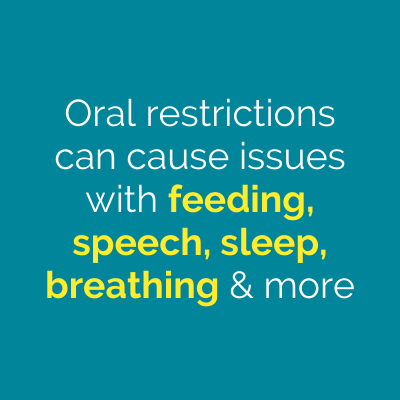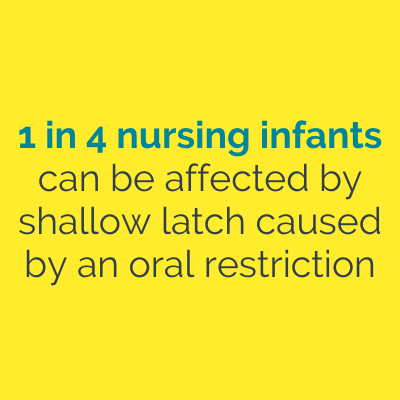We're all born with tiny bits of tissue (also called frenum, frenulum or oral tethers) under our tongue and upper lip, and inside our cheeks.
But sometimes, babies are born with oral tethers that are too tight, too stiff or too short — otherwise known as tongue or lip tie — that restricts the normal movement and function of the tongue and mouth.
Over the course of a lifetime, this can lead to several health issues, including difficulties with nursing, feeding, speech, sleep & breathing problems, among others.








Estimated babies in the world born with tongue tie
Babies born with tongue tie every year (based on 10% of all births)
Nursing infants that can be affected by shallow latch due to an oral restriction
.png?width=750&name=Tongue-lip-buccal-tie%20(1).png)
An oral restriction can directly and indirectly affect the rest of your body, leading to health problems at each stage of development if left untreated.
Sleep-related issues:
Dental issues:
Mental health and behavioral issues:
Respiratory issues:
Serious and chronic health issues:
But if left untreated, tongue tie can actually have long-term effects on your body — leading to health problems at each stage of development from childhood into adulthood.
Learn more about the 3 key concepts of how oral restrictions lead to muscle and bone changes, which affect how we breathe, sleep, eat & communicate.
Simply put, there are a lot of muscles attached to underlying bones (called orofacial muscles) that are being recruited thousands of times a day to make the functional movements of the face.
If you thought that was surprising, then swallowing, eating and speaking take it to the next level.
Eating and swallowing are complex behaviors involving reflexive activities of more than 30 nerves and muscles. There are muscles in the lips, tongue and throat, as well as your cheeks and jaw.
And to speak well, timing is important. Speech and language take about 100 muscles! When you talk, you need to move, tense and/or relax the muscles in your face at the right time. Sometimes simultaneously. Crazy right!
When these muscles are tight, restricted, or not free to move in their proper sequence, it results in oral dysfunction. But life cannot end. As humans, we persevere. We must go on with our lives and do things differently. We may have a uniquely crooked smile, we may struggle to chew and swallow so gravitate to softer and easier to manage foods, we may dribble or choke when we drink or mumble or muffle our spoken word.
These are all compensations for oral dysfunction. Tongue-tie may be the “buzzword” that everyone is searching for on Google these days, but oral dysfunction is the real problem.
Sing along: "The leg bone's connected to the knee bone. The knee bone's connected to the thigh bone. The thigh bone's connected to the hip bone..." and so on.
What was missed in this classic song was what is really important to Dem' bones: The muscles that pull and push on our bones.
Yes, the primary function of the muscles is to move the larger structural supportive bones that help us move. At a boney cellular level, the forces the muscles place on your bones — you got it — CHANGE bone.
That's right: Muscles CHANGE bone. Because a bone is reactive to the muscle that surrounds it.
Thus, the logical conclusion is if your muscles are not working properly, then your bone frame will grow inappropriately to compensate.
Oral health professionals and supportive oral motor specialists (as well as others in the medical field) are starting to see this exact change play out in their patients’ faces.
If you have less coordination with your muscles in your mouth (as mentioned in CONCEPT #1), you may speak less clearly. Also, it may be hard to chew or swallow food.
But there's one thing even MORE important that's impacted by oral dysfunction, which is impossible to live without: Oxygen.
If you have less coordination with your muscles in your mouth (as mentioned in CONCEPT #1), you may speak less clearly. Also, it may be hard to chew or swallow food.
But there's one thing even MORE important that's impacted by oral dysfunction, which is impossible to live without: Oxygen.
There seems to be one thing without research that all medical experts and professionals can agree on: Breathing is important for staying alive.
And we can NOT compensate for a lack of oxygen in our bodies.
It turns out that humans — no matter what the age — that have oral dysfunction are silently making slow day-by-day, cell-by-cell changes to the bony structure of the lower face, mouth/nasal capacity, which leads to a compromised airway. Alarming right!
The mountain of evidence that is still under interpretation seems to be pointing at the dysfunctional oral patterns of the human mouth. Not only are the dentists that focus on the oral cavity and the myofunctional therapists who support them noticing these changes, but also medical professionals are alarmed by the increasing rate of behavior-related issues that can be attributed to poor breathing — especially during sleep.
There's good news though: It turns out that working together, both medical and dental professionals can prevent, slow or even reverse these airway-related issues the earlier we catch these dysfunctional patterns.